
Chords in the ukulele
Content
The notion of intervalsCreating chords by harmonization of scales
Ukulele chords in first position
Accompaniment by strumming of chords
Nuclei of ukulele chords for major and minor tonalities
Basic ukulele chord families
Chord progressions
In the previous section we completed the definition and distribution of scales on the ukulele fingerboard. When studying these scale fingerings we highlighted the major and minor chords around which these fingerings are constructed; however we did not study the theory that refers to these chords. The study of the theory on which the construction of chords is based was carried out in the Chords section of the Theory page; the elaboration of fingerings of these chords on the fretboard of the ukulele is the objective of this section.
There is a huge number of chords that can be implemented in the ukulele; therefore, without at least a basic knowledge of how these chords are generated and what function they fulfill, it is difficult to be oriented in the selection of the most appropriate to achieve sustained progress throughout their learning. Mastering a minimum of theory is required to apply a rational approach to their selection..
The notion of intervals
The study of the scales of the previous chapter is basic for the study of the chords to be addressed in this page; however, it is necessary to pave the way towards understanding the nature of chords by studying the musical intervals: the separation between musical notes. In fact, the notion of intervals in the study of the ukulele was present from the very moment we considered its tuning: when using the fret for a string to fine tune another what we do is set the musical interval to which the second is in relation to the first.
The musical intervals were already studied in the Intervals section of the Theory. In the Interval Characteristics subsection of that section is given a table listing the names of all the intervals and their extension in semitones over the range of an octave.
A fundamental characteristic of the intervals, and which will be crucial in the elaboration of chords, is that of their consonance. When their notes emitted simultaneously, harmonic interval, produce a pleasant sound it is said that the interval is consonant and when they produce an unpleasant sound it is said to be dissonant. We already experimented this type of situation when we started searching for musical notes at the beginning of the theory pages. However, it is convenient to point out that the perception of consonance or dissonance of the intervals is somewhat subjective, but that in our western culture there is some consensus in this regard, summarized in the following table already shown in the theory, but that it is convenient to repeat before continuing with our exposition:
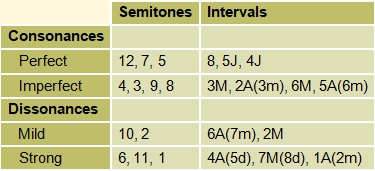
In this section we will concentrate on emphasizing their relationship to scales and, as a consequence of this relationship, to chords. Below is the linear representation of the Dmajor scale with an indication of its degrees, the notes corresponding to each of these degrees and the interval of each of these notes with respect to the C note corresponding to the first degree of the scale:

The P corresponds to the denomination of perfect, and M to the denomination of mayor.
Compare this situation with the one for the natural minor scales:

The m corresponds here to the denomination of minor..
The following facts stand out from this comparison:
- Intervals 1P, 4P, 5P and 8P appear on both scales. If any the notes corresponding to these intervals are executed together with the tonic, a pleasant sound is obtained, they are consonant intervals.
- The 2M interval also appears on both scales, but if the note corresponding to this interval is executed together with the tonic, an unpleasant sound is obtained, it is a disonante interval.
- The two scales differ in their intervals of third (3M and 3m), sixth (6M and 6m) and seventh (7M and 7m).It is these degrees that establish the major or minor nature of a scale.
Creation of chords by harmonization of scales
The creation of chords by harmonization of scales was studied in the Chords section of the page dedicated to Theory. Recall that the fundamental concept is to add notes separated by intervals of third to each of the notes of the scale.
Harmonization of major scales
Harmonization with triads
The simplest harmonization is triad harmonization. To harmonize the first degree of the scale of the C major we take the tonic note C as the first of the chord and then we count three notes: C, D and E, the note E will be the second of the chord. We count again three notes: E, F and G, the note G will be the third of the triad. The same procedure applies to the harmonization of the other degrees of the scale:
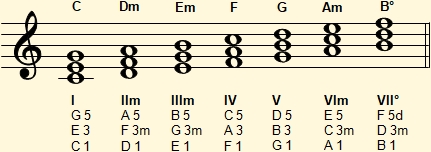
In the description of the chords, at the bottom of the diagram, the first row corresponds to the general identification of the chords used in the harmonization of the major scales, the second to the specific names of the chords corresponding to the particular scale considered, and the last three rows to the notes that constitute these chords. In the theory some observations are made regarding the composition of intervals of these chords and their consonance or dissonance that should be taken into account. At this point we are interested in pointing out that the notes resulting from the harmonization of the C, F and G notes of the scale are precisely the shaded notes in the diagrams of the digitation of the open major scales obtained in the Major scales subsection of the Scales section of this page:
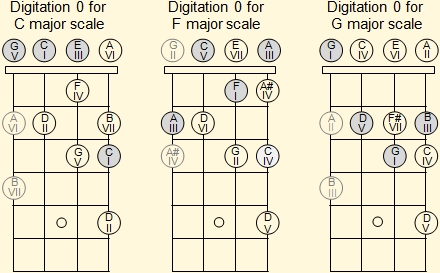
Note that the set of major chords C, F and G, corresponding to the three major degrees of the scale (I, IV and V) contains all the notes of the C major scale. They make up what we will call a family of chords for the tone of C major, enough to accompany a large number of melodies in this key. Our main task in this study will be the identification of chord families for each of the tonalities. Let's look at an example of the use of the basic family for the C major tonality in the accompaniment of "Twinkle, Twinkle Little Star":
Here is the interpretation of this arrangement in UkeleleMate:
If you watch this video carefully, you will notice that at each occurrence of the G chord the white dot that indicates the melody fingering always matches one of its notes
Harmonization with seventh chords
Since the ukulele has four strings it is possible to harmonize not only with triads but with four-note chords. If we add to each of the triads previously obtained in the harmonization of the major scale a note that is at a third interval from its last note, at a seventh interval from the tonic, we will obtain:
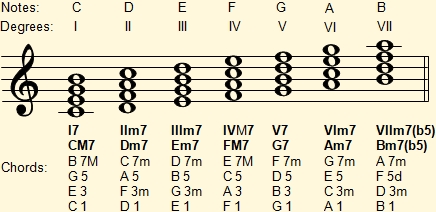
In the theory some observations were made regarding these seventh chords, which we repeat below:
- There are two types of seventh intervals, which is why they are expressly identified in the list of chord notes, and four types of seventh chords.
- On degrees I and IV we obtain major seventh chords: to a major triad we add a note that forms a major seventh interval with the tonic (see the section dedicated to intervals).
- On degrees II, III and VI we obtain minor seventh chords: a note that forms a minor seventh interval with the tonic is added to a minor triad.
- On the V degree a dominant seventh chord is obtained: a note that forms a minor seventh interval with the tonic is added to a major triad.
- On grade VII a minor seventh chord with diminished fifth is obtained: a note that forms a minor seventh interval with the tonic is added to a minor triad with diminished fifth.
Since the grade V is the second most important, after the tonic grade, in the execution of the ukulele we will make extensive use of the dominant seventh V7 chords, since their note corresponding to the seventh degree gives a better resolution to the tonic chord than the one possessed by the V chord. The following score uses G7 instead of the G chord in the accompaniment.
Harmonization of natural minor scales
The following diagram illustrates the harmonization of the natural minor scale of A by means of triads made up of notes separated by third intervals.
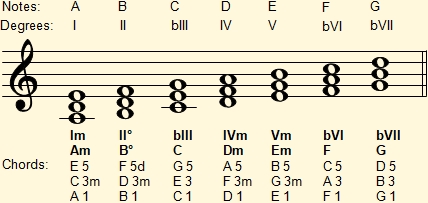
If this harmonization is compared with that of the major scale for C it is seen that they have the same chords but in a different order. This is a particular example of the general fact that a minor relative scale (natural) corresponds to every major scale that is constructed from its sixth grade (nine semitones after the tonic; or equivalently, three semitones before the eighth tonic) and that has exactly the same notes; and vice versa: at every natural minor scale a major relative scale corresponds that has exactly the same notes and is constructed from its grade bIII (three semitones after the tonic):

If we compare the notes of the chords resulting from the harmonization of the degrees I, IVm and Vm of the A natural minor scale with the notes the open A, D and E natural minor scales we obtained in the previous page and repeat below, we note that the shaded notes of each scale correspond to the notes of the chords resulting from the harmonization of these degrees:
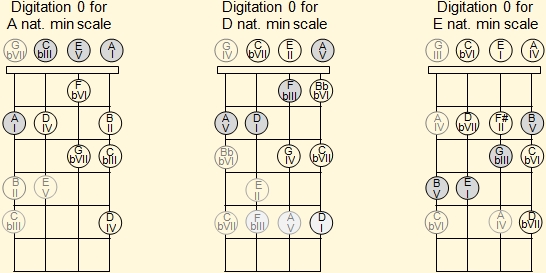
Note that the set of minor chords Am, Dm and Em, corresponding to the three major degrees of the natural minor scale (I, IVm and Vm) contains all the notes of the A natural minor scale. They make up the family of basic chords of the tonality, enough to accompany a large number of melodies in this tonality.
The procedure to harmonize the A natural minor scale by means of sevenths is the same as that used to harmonize the C major scale by means of sevenths: add to each of the chords obtained in the harmonization by means of triads a fourth note at an interval of third of the third note of the triad, so it is not necessary to repeat this procedure. The minor chord resulting from the harmonization of the fifth grade would thus be a minor seventh chord Vm7, but in these pages we will generally favor the use of the same seventh dominant chord V7 used for major tonalities. Thus, for the A minor tonality we will use the E7 chord instead of the Em7 chord. In the following figure both chords are contrasted:
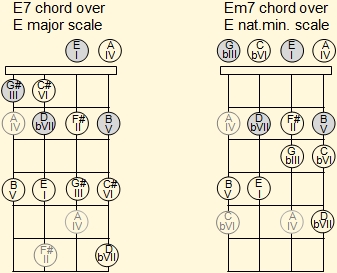
Let's look at an example of the use of the basic family for the A minor tonality in the accompaniment of the beautiful "Study in E minor", by Tárrega. We will transport this melody since the E minor tonality does not lend itself to its execution in the ukulele; we chose for this the A minor tonality, the closest to E minor and that allows the use of a low register with open strings. The basic family of this tonality is constituted by the chords Am (Im), Dm (IVm) and E7 (V7) (Increase the corresponding chords of the basic family Em, Am and B7 for E minor by five semitones):
The following video shows the execution of this study in the UkeleleMate program:
Functions of the scale degrees
A detail whose importance will become evident when we consider the selection of chords for the accompaniment of melodies in major and minor tonalities, is that degrees I, IV and V of major and minor scales establish the tonality: in the harmonization of major scales we find that the chords built on these degrees are major and in the harmonization of minor scales are all minor. It is then said that these degrees have a tonal function, and the set of chords built upon them will be basic in the accompaniment of melodies in their corresponding tonality.
Ukulele chords in first position
The theory of the previous section allows us to determine the major, minor and seventh chords for any tonality. Now, remember that we want to rationalize chord learning; our first step towards this rationalization is the identification of a set of chord digitations that allow us the digitation of other chords. To do this, in a manner similar to that used for the identification of a minimum set of basic digitations for fingering the scales, we will begin by identifying a minimum set of digitations of chords to be used in other chords.
Major chords in first position
The major chords for the seven natural notes are illustrated below:
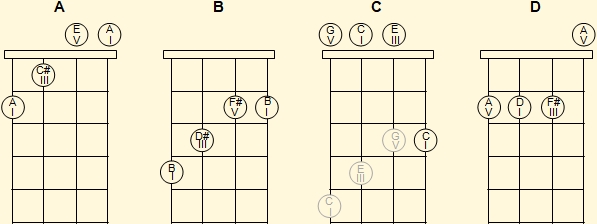
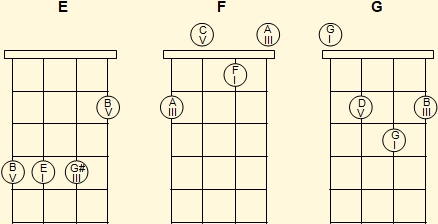
Minimum set of basic digitations for major chords
Closely related to what happened for the major scales, the observation of the previous set of digitations reveals that there is a minimum of three major chords digitations sufficient to generate the rest of the major chords, those corresponding to the A, D and F digitations:

By moving these digitaciones along the fingerboard, other chords can be obtained. This is illustrated in the previous figure: moving the three frets down the fingerboard of the ukulele Digitation A, a second fingering is obtained for the C major chord.
Observations:
- As you will see later, it is important when memorizing these chords take into account the position of the tonic note, corresponding to the first degree of the scale. The position of the notes for grades III and Vare obtained, in order, to the right and re-entering the fingerboard of the ukulele by its third string.Remember that, from the point of view of its range of notes, the ukulele is a three-string instrument(the first three).
- The C chord in its first position, for its ease of fingering, is one of the first chords to learn in the ukulele, but it has not been included in the set of basic fingerings because it is desired that this set is minimal.
Minor chords in first position
The minor chords for the seven natural notes are illustrated below:
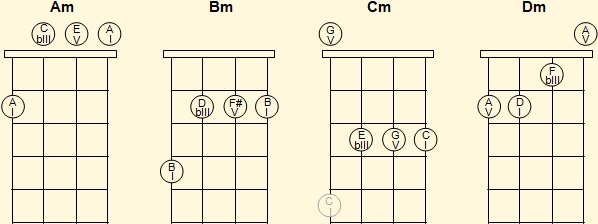
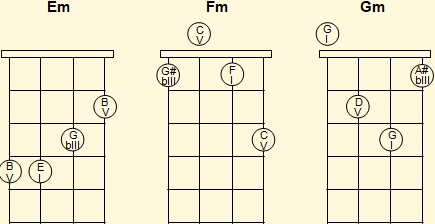
Minimum set of basic digitations for minor chords
In close relation to what happened for the minor scales, the observation of the previous set of fingerings reveals that there is a minimum of three digitations of minor chords sufficient to generate the rest of the minor chords, those corresponding to those of the minor chords for A, B and G:

By moving these fingerings along the fretboard you can get other chords. This is illustrated in the figure above: moving Digitation A three frets down the fretboard of the ukulele gives a second fingering for the C minor chord.
Observations:
- Remember that when memorizing basic chord fingering it is important to take into account the position of the different grades of the notes that make them up.
- The digitation Gm is shown with an extension of only three frets, but it also used in the manner shown above:

Relationship between basic digitations for major and minor chords
Once the basic digitations for the major chords have been memorized, the basic digitations for the minor chords are practically memorized, just move up one fret the note corresponding to degree III to get the note corresponding to grade bIII:

Seventh dominant chords in first position
The dominant seventh major chords for the seven natural notes are illustrated below:
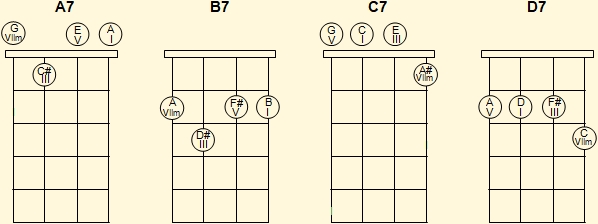
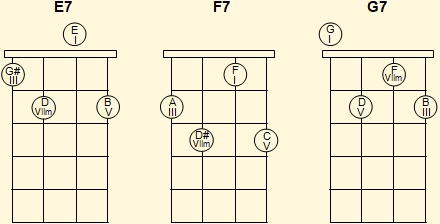
Minimum set of basic digitations for dominant seventh chords
The observation of the previous set of digitations reveals that there is a minimum of three dominant seventh digitations sufficient to generate all the dominant seventh chords:

Observations:
- The second of these digitations could have been called Digitation C7 since it is the one above the fretboard, but it has been chosen to call it D7 to use the same tonics, A, D and F, in each of the sets of basic digitations, for major, minor and dominant seventh chords.
- These basic digitations can be obtained from the basic digitations for major chords simply by adding the degree corresponding to degree bVII and reorganizing, if necessary, the notes to contain them in a range of three frets
The techniques used to obtain a set of basic digitations from other given: alteration of the note corresponding to one of the degrees of these digitations and to add a note corresponding to a degree not present, are the basic techniques that we will use later to obtain Other types of chords..
Accompaniment by strumming of chords
We will dedicate a chapter to the study of some fundamental rhythms, but in preparation for the execution of the melodies considered in the practical exercises of this page it is necessary to describe the way in which the strumming will be indicated for the accompaniment of these melodies.
Sometimes the rhythm to be used in a piece is indicated in a concise way at the beginning of the score:

In the following recording this indication was used to add a rhythmic accompaniment of chords for this simple arrangement of a portion of "Swan Lake" in A minor:
Normally this is not the case, so you must choose between a set of accompaniment schemes appropriate for the type of measures used in the piece, which will always be indicated at the beginning of the score following the key signature; in this example you have 4/4 measures. With diligent study and practice you can perform this and other more complex accompaniments, for now we will deal with much less elaborate ones.
The following diagram is an example of the way in which rhythmic accompaniment by chords will be indicated on these pages.

This scheme applies to each of the measures, and in it:
- The first row indicates, in the standard notation, the duration assigned to each of the strumming strokes.
- The second row shows the beat count of the measure, which controls the position of the strumming strokes.
- The third row indicates the direction of each of the strumming strokes.
- Capital letters are used to indicate strong times.
In this example you have 4/4 measures: four beats of quarter note duration for each measure. The first beat corresponds to a quarter note, therefore a first strumming stroke is executed downwards and a "one" is counted; this blow is executed with more force than the others. The second beat is divided into two eighth notes, so two strokes of the strum are executed in rapid succession, one down and one up counting "two and". The third beat of the measure corresponds to a quarter note, therefore a fourth blow down is executed and "three" is counted. Finally, the fourth beat is also divided into two eighth notes, so the fifth and sixth strokes are executed in rapid succession, one down and one up counting "four and".
In these pages you will be shown other accompaniment schemes, and with study and practice you will learn to create your own schemes, in this way you will be able to approach the accompaniment of pieces whose transcripts do not contain rhythm information.
Basic strumming for 2/4 measures
The simple strumming scheme shown below will be useful for the accompaniment of melodies that use 2/4 measures in some of the first exercises proposed:

You can execute it using your fleshy side of the thumb or index fingernail for all strokes.
Here is the score and tablature of "Row, Row, Row Your Boat", which you can use to practice your accompaniment through the basic scheme for 2/4 measures. This is an very simple exercise since only the C major is used in the accompaniment.
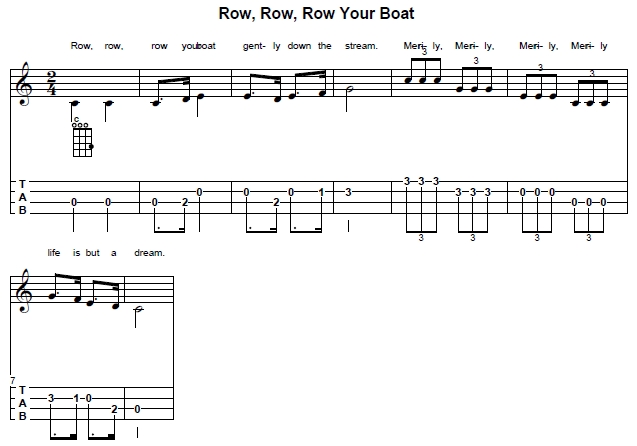
Accompany the following recording of the melody of "Row, Row, Row Your Boat" with your ukulele and using the basic strumming pattern for 2/4 measures and the C major chord.
You can experiment with how to execute the strokes until you find the one that suits you best. For example, you can use the fleshy side of the thumb for the downward strokes and the fleshy tip of the index for the upward strokes. In any case, the chosen form must allow it to maintain a uniform flow in the accompaniment.
To help you get in sync with the melody, a first bar of beats has been added. Count "One", "Two" and then start strumming.
The fact that in the arrangement of "Row, Row, Row Your Boat" which we use to study the accompaniment of melodies that use 2/4 measures a single chord is used allows us to concentrate on the use of the right hand, responsible for strumming; the only function of the left hand is to keep your ring finger pressing the third fret of the first string, so that only C major chords are emitted during strumming.
"Row, Row, Row Your Boat" is interesting because of the flow of its melody. However, there are few pieces that use a single chord and their harmonization contributes to beautify them.
Next we give the basic strumming for 4/4 measures and 3/4 measures, more common than those of 2/4, but we will postpone the examples of the use of these strumming to the next section, once we have basic nucleuses of chords for accompaniment.
Basic strumming for 4/4 measures
The simple strumming scheme shown below will serve for the accompaniment of melodies that use 4/4 in some of the first proposed exercises:

It can be performed using the fleshy side of the thumb or index fingernail.
Basic strumming for 3/4 measures
The simple strumming scheme shown below will serve for the accompaniment of melodies that use 3/4 measures in some of the first proposed exercises:

You can performed it using your fleshy side of the thumb or index fingernail.
Nuclei of ukulele chords for major and minor tonalities
Our first step towards the rationalization of the study of chords for the ukulele was the study of the creation of chords by harmonization of scales through third intervals, the second step will be the identification of the basic chords in the accompaniment of melodies in major and minor tonalities.
When reviewing a significant number of melodies, both in major and minor tonalities, you will find that the two most frequently used chords are those that are built on the first and fifth degrees of the tonality; in fact, some melodies use only these two chords, which constitute what we will call the nuclei of a tonality. The nucleus of the natural tones are shown below:

Let's look at two examples of melodies that use only the nuclei of the tonalities, one in major tonalitty and one in minor tonality.
Below is the score-tablature of "He´s Got The Whole World In His Hands, in D major:
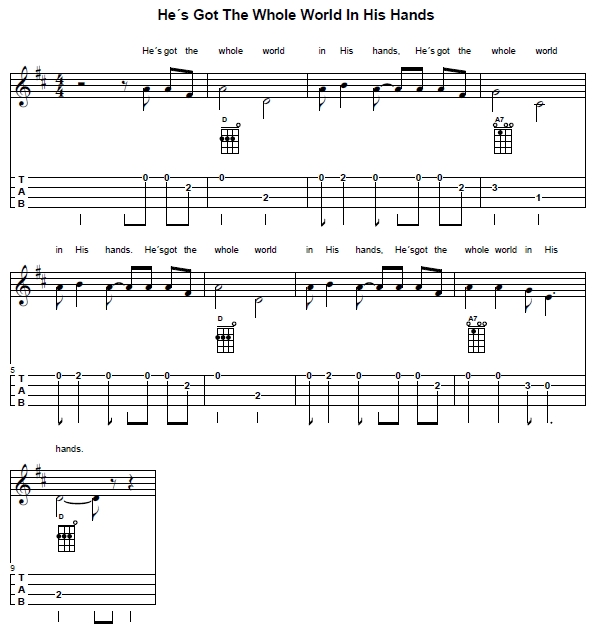
The following video shows the performance of "He's Got The Whole World in His Hands" in D major using the program UkuleleMate and only the D and A7 chords:
Be ready to initiate the strumming with the note corresponding to "world" in the first beat of the second measure.
Note: this melody is considered in D major because the standard ukulele, with high G string, does not have the lowest note of the melody if played in C major. However, it is possible to accompany "He's Got The Whole World in His Hands" in C major using a ukulele with standard tuning if the melody is played on another instrument.
Be ready to initiate the strumming with the note corresponding to "world" in the first beat of the second measure.
Let's now look at a melody from Mexican folklore, "La Sandunga", which uses 3/4. The following ia its execution in D minor using only Dm and A7 chords:
The following is a transcription without an introduction, which will help you to practice your accompaniment:
Be ready to initiate the strumming with the note corresponding to "world" in the first beat of the second measure.
Basic chord families for the ukulele
When studying the harmonization of scales we saw that the chords built on degrees I, IV and V of a scale establish the tonality and we said that they would be basic in the accompaniment of melodies in major and minor tonalities. The two melodies considered in the previous section confirm the importance of the triad built on the first grade and the seventh chord built on the fifth degree, and together we consider these two chords as the nucleus of the tonality. Now, it is possible to verify the importance of the chord built on the fourth degree by studying a significant number of melodies. In this section we will consider melodies that use this chord, one in a major tonality and one in a minor tonality.
The following is a simple arrangement of "Amazing Grace" in C major:
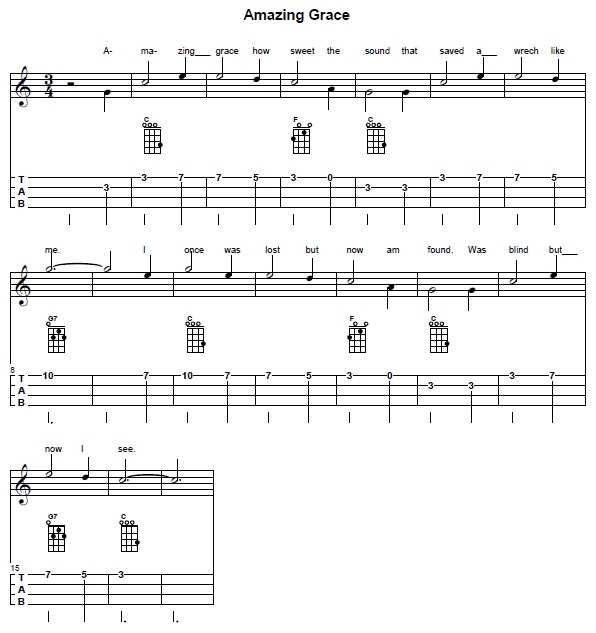
Next the execution of this arrangement using the basic pattern of accompaniment for melodies in rhythm of 3/4.
Be ready to initiate the strumming with the note corresponding to "world" in the first beat of the second measure.
The following is a simple arrangement of the first part of the "Study in Mi minor", by Tárrega, in the A minor tonality. The chords Am (Im), Dm (IVm) and E7 (V7) are used:
The following is the execution of this arrangement in the ukulele, using the program UkuleleMate:
The objective of considering the "Study in Mi minor" is to show that, as in the case of major tones, the chords constructed on degrees I, IV and V of the minor scale are basic in the accompaniment of minor tonality; however, if you wish, you can perform the following exercise.
Note that the score uses 9/8 bars, nine eighth notes per bar. It is sufficient to simply strum the indicated chord at the beginning of each measure and, although not indicated, also at the beginning of the fifth measure. If you wish, and once you have practiced the above accompaniment, you can play the chords at the beginning of each group of three notes. Finally, you can play the chords in each of the nine beats of the measures. In the last two cases, it may be easier for you to maintain the rhythm if you execute the strumming by groups of three beats as follows:

You can use the side of the thumb for the downstrokes and the fleshy tip of the index for the upstrokes.
To assist you in this practice, the recording includes three metronome beats that mark the beginning of each group of three eighth notes of a measure prior to the melody.
The two previous examples have served to verify the importance of chords built on degrees I, IV and V in the accompaniment of melodies; we had previously determined that chords I (Im) and V7 built on degrees I and V can be considered as the nucleus for the accompaniment. Now, the IV chord (Ivm) built on the IV degree in conjunction with the IV7 seventh chord built on the first degree in conjunction with the IV chord (IVm) forms the nucleus of the key corresponding to the IV degree, so it seems likely to play an important role in the accompaniment of melodies. Next we will show a melody that shows that this is indeed the case.
The following is a simple arrangement of the first part of "When The Saints Go Marching In", in C major. Chords C (I), G7 (V7), F(IV) and C7 (I7) are used:
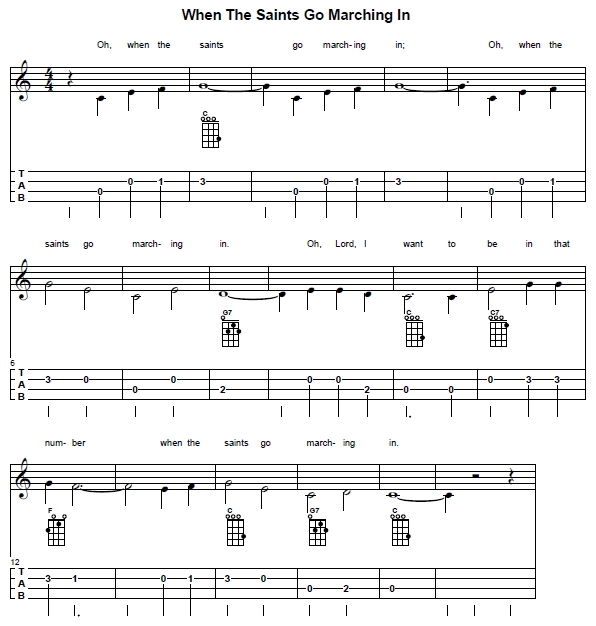
The following is the execution of this arrangement in the ukulele:
Note that you must start your accompaniment on the second measure.
What has been studied in this section allows us to create the following basic families for accompaniment in major and minor tonalities:
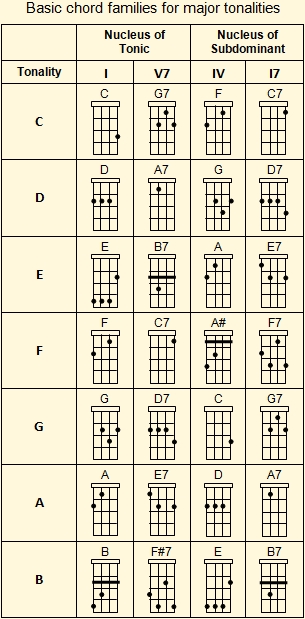

Chord Progressions
The study of the different melodies considered so far allowed us to identify some basic families of chords, but to understand and become familiar with the way they are normally used will take some time. With this goal in mind, we examine these melodies to determine their different chord progressions, chord sequences that begin and end in the chord corresponding to the first degree; the result is summarized in the following tables:
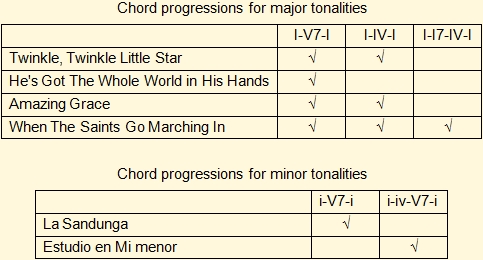
NOTE: until now we have used a terminal "n" to identify minor chords, in the second table we have used lower case for this same purpose, another very common notation to identify minor chords.
The set of melodies considered constitutes a very small sample to give rise to definitive conclusions, but it allows the observation of some significant details. Consider the case of major tonalities, for which we have a larger sample. The method used to arrive at some conclusions is not formal, but is based on concepts that we have previously introduced in these pages, such as scales, intervals, and consonance and dissonance. Terms such as tension and resolution are used, the significance of which will be understood from the exposition that follows.
The main analytical resource we will use is the following table, which highlights the harmonization of major scales, as we are using it, in a useful presentation to understand how the progressions of already identified major tonalities evolve:
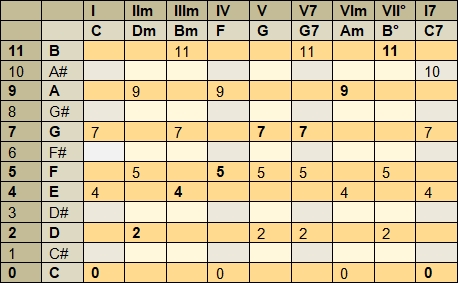
This table has a general application, simply changing the names of the notes in the second column and the chords in the second row, but emphasizes the key of C major because it was used in our studies. The seven rows corresponding to the seven degrees of the scale have been shaded in cream, and the four chords that make up our basic family have been shaded in gray: chords C, F, G7 and I7 corresponding to degrees I, IV, V and I, respectively. To avoid confusion with the scale degrees and because it is more convenient to identify the amplitude (in tones and semitones) of the relative alterations of the notes of the chords as one progresses, Arabic numerals have been used to indicate the composition of the chords in terms of the amplitude of the interval with respect to the tonic of the scale.
Before starting with the analysis of the progressions obtained it is important to emphasize that a major chord, such as the I from which all these progressions start, is constituted by the tonic note, a second note that is at a third major interval (imperfect consonance) with respect to this tonic and a third note that is at a perfect fifth interval (perfect consonance). All this consonance gives the chord I a high degree of stability, a feeling of rest within the piece. When moving towards other chords within the progression, this stability is affected by the variation in the amplitude of the different resulting intervals and the need to restore this resting condition is felt. The function of these progressions is then to introduce variety and interest by creating tension and the resolution of this tension by returning to the tonic chord or to any other stable chord. When reading the following it is necessary that you remember exactly the definitions of the different intervals given in the first section of this pages, or that you have the summary tables on the properties of the intervals. It is also important that you remember that it is degrees I, IV and V that have a tonal function.
When contrasting the progressions obtained for the major tonalities with the information in this table, we observe that:
- In the progression I-V7-I, passing from chord I to chord V7: the tonic note C is raised in a tone, thus losing part of the enclave to the tonality, which is retained through the note G which is maintained at a perfect fifth interval (7 semitones, perfect consonance) of C. The note E placed at a major third interval(4 semitones, imperfect consonance) of the tonic C is raised by a semitone, whereby this becomes a pefect fourth interval (5 semitones, perfect consonance) with respect to C. The B note is added at a minor seventh interval(10 semitones, soft dissonance) of C. It is this last note that creates the tension in the progression and causes the resulting dominant seventh V7 chord to ask for resolving (returning) to the major I chord. Using a major V chord for the harmonization of the fifth degree does not have such a marked tendency to resolve the I chord. The return of the V7 chord to the I chord implies an inverse process.
- In progression I-IV-I the passage from chord I to chord IV: the tonic note C is maintained, thus retaining the most important note of the tonality. The note E placed at a major third interval (4 semitones, imperfect consonance) of tonic C is raised in a semitone, so that it becomes a perfect fourth interval (5 semitones,perfect consonance) with respect to C; but more importantly: the resulting note F occupies the fourth degree of the major scale of C, which also has a tonal function. Finally, the note G placed at a perfect fifth(7 semitones, perfect consonance) of the tonic C is raised in a tone, leaving it at an interval of major sixth(9 semitones, imperfect consonance) and the tonal function of the fifth degree is lost. According to this analysis, the transition from chord I to chord IV does not imply the same degree of tension as the transition to degree V, so you can stay in it longer. In fact, there are melodies in which the IV chord is maintained for three or more measures.
- In the I7-IV-I progression, the passage from chord I to chord I7 keeps all the notes of the chord and only the note A# corresponding to degree bVII is added to a minor seventh interval (10 semitones, soft dissonance)of tonic C. This new note, although not very dissonant, introduces the need for resolution, and we would like it to go towards one of the chords built on tonal degrees I, IV and V. The first and obvious possibility is simply to return to chord C (degree I), this would be the case if the only effect sought was to adorn the strumming by means of a transient sound effect of very short duration. We are left as candidates the chords IV and V7, both appropriate, but we will only analyze the one we are in the given progression, the IV.If the transitory note A# is eliminated, apears the chord I again, whose passage to chord IV has already been analyzed.
We limited ourselves to the analysis of progressions for major tones, but the analysis of progressions in minor tonalities follows the same guidelines. It is only necessary to adapt the table to the minor scale.
Various